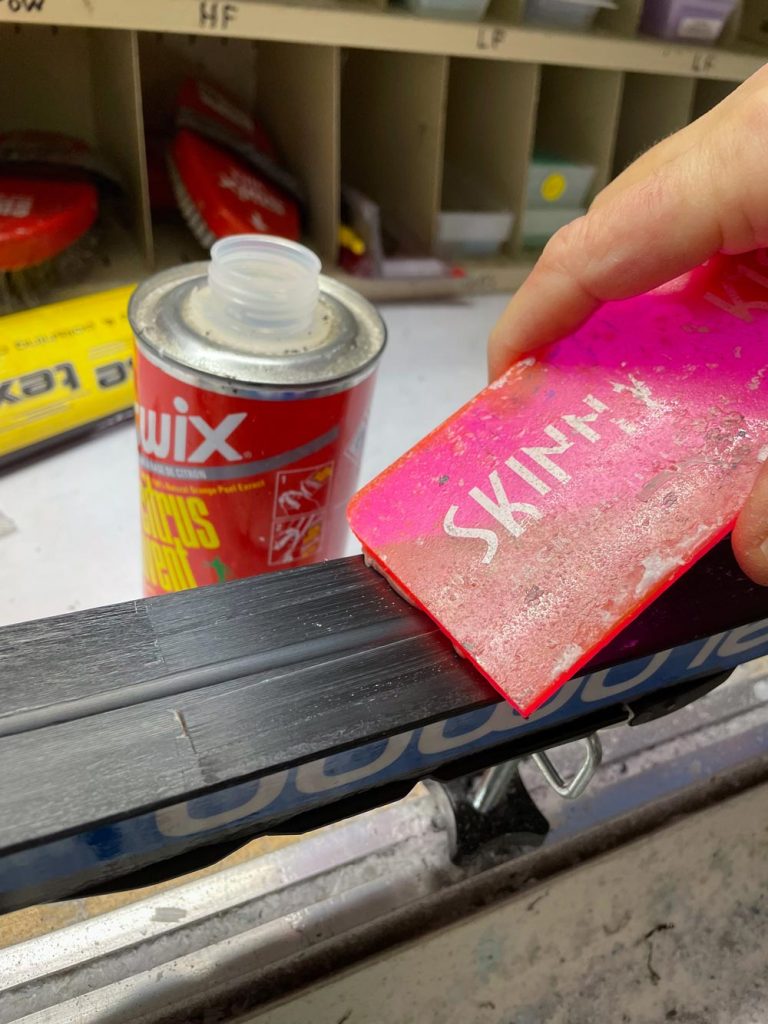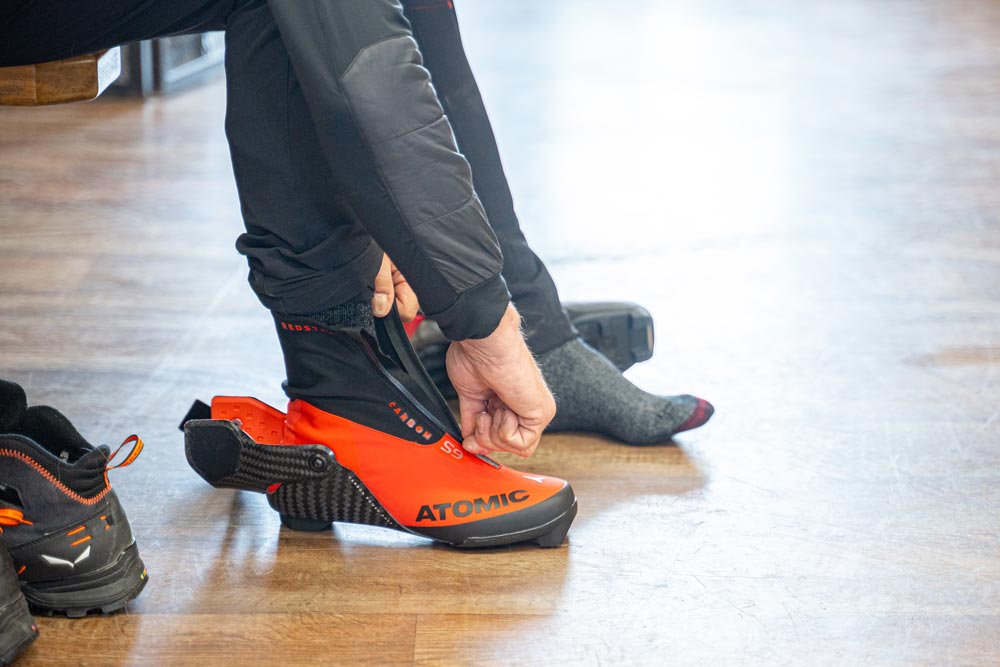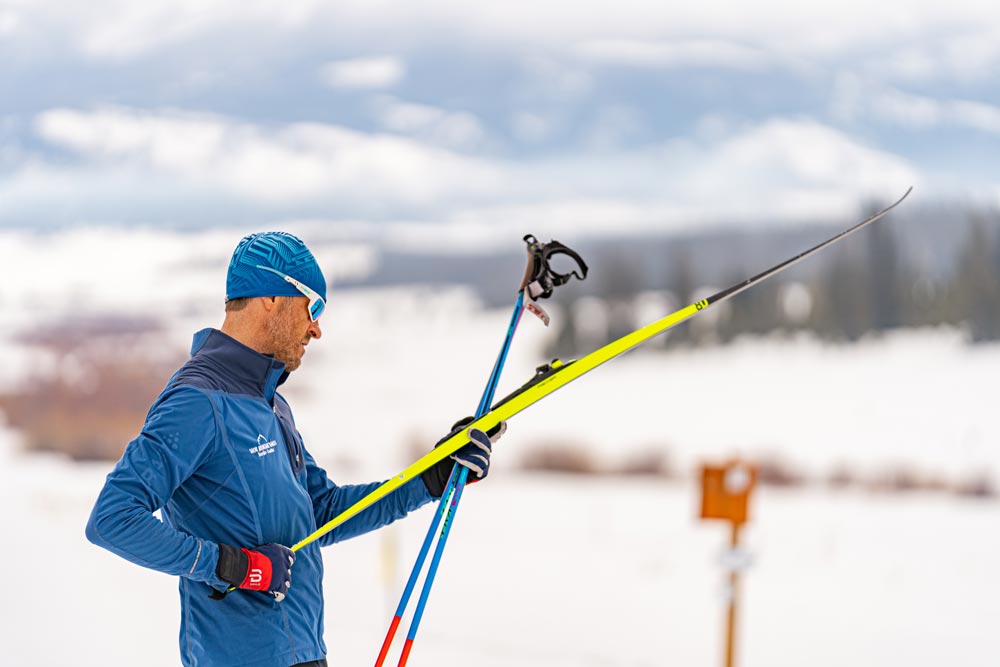
[Photo] Cody Downard
If you were a 19th-century pioneer traveling across the American West, you knew how to take care of your gear. Tear a boot sole or jam a rifle barrel on the open plains and it was up to you to make the repair. In some cases, your family and livelihood may have even depended on it. Fixing your important possessions often meant relying on minimal resources, which made general care and maintenance that much more important.
We no longer need skis to traverse the land and hunt for our own survival, but the spirit of Nordic skiing still encourages adventure and exploration. And as the pioneers knew, keeping gear in good shape averts on-the-trail repairs and helps it last. Sure, skis, boots and poles will inevitably need replacing (for that, check out our annual Gear Guide on p. 52), but a few simple steps and materials can go a long way toward adding years of enjoyment on your favorite winter tools.
Skis: Clean and Bag ’Em
Even when they’re not on the snow, keep skate ski bases waxed. Some refer to this dryland application as “travel wax” or “storage wax.” Iron in a layer of paraffin wax to protect the bases from the elements and shield them from scratches and dings.
Right after skiing, spend a few extra minutes applying wax, then scrape it off shortly before your next outing, and you’ll enjoy a pair of skis with better glide and, ultimately, longer life. Use a nonfluorinated, semi-hard wax designed for the 15° to 20° F range. It will help repel dirt, perform well enough for training even as temperatures rise and serve as a great base for warmer waxes when needed. Even if you make the effort to put some wax into your skis only once every week or two, you’ll notice a difference in the quality of your glide.
For classic skis (without skins), apply travel/storage wax only to the glide zones during the season. Clean off the kickwax after each session; doing so not only keeps your ski bag and/or vehicle cleaner but means that you’ll be more apt to wax for current conditions the next time you head out. With skin skis, invest in a dedicated skin cleaning product (sold by most wax manufacturers) and apply it regularly after skiing.
During the summer, clean the relevant zones of your skis with dedicated glide, kickwax and skin cleaners. Then apply a slightly warmer wax than your usual mid-winter travel one to the glide zones and keep skis in a cool, dry place. Although not perishable like many items in your pantry, skis can still be affected by excessive heat and humidity, which can compromise the wood and laminate layers or glue.
For transport when driving, consider using a ski bag rather than having skis floating loose in your vehicle or roof box. Who hasn’t accidentally hit the brakes a little hard at a red light and ended up with skis in the front seat? Bagging your skis avoids all sorts of issues and makes organizing easier.
Boots: The Beauty of a Little Beeswax

[Photo] Thomas Doerr
Remember those pioneers on the trail, whose boots provided critical protection from rocks, snakes, mud and underbrush? Skiers, surprisingly, encounter many of the same hazards— even the odd snake or two when rollerskiing. The point is, there’s plenty that can harm the life and functionality of your ski boots. Good maintenance practices can help you avoid an expensive replacement.
Much as it helped protect and enhance the footwear of old, beeswax is a natural option for water resistance and lubrication that can be useful on ski boots. While they aren’t made of leather anymore, ski boots still feature plenty of seams and stitching that undergo a lot of wear and tear. Just think how many times you flex the sole of your boots in a single tour on local trails.
Find beeswax at your local hardware store or at footwear retailers that carry leather work boots. It can be applied in liquid form, using nylon or latex gloves, or even with an old rag. After applying beeswax to your boots, heat them lightly with a hair dryer or heat gun to allow the wax to penetrate a bit, then wipe boots dry with a cloth or paper towel. Because of the plastics and carbon used in today’s ski boots, the wax won’t coat everything, but it will get to the areas that need it most and help repel moisture, dirt and salt (from rollerskiing on roads).
Stiff, protective boots can stand up to repeated months of use in summer and winter but become unbearably frustrating when a simple busted zipper won’t close—especially just when you need to get to the start line. Occasionally applying a little beeswax or petroleum jelly to zippers can provide the lubrication and protection necessary to avoid icy snags and frozen snaps in the first place.
Your feet only ever experience the inside of your boots, so make sure to care for those, too. Use a boot dryer, even in summer after rollerskiing, to dry out sweat and water. Sometimes no electric boot dryer can beat the work of a crackling wood stove; just don’t place boots too close. Ideally, remove the insoles after each use to keep the interior of your boots fresh—a benefit to you and anybody with whom you travel or live.
Poles: Protection Is Key

[Photo] Thomas Doerr
When it comes to dollars-per-gram, your poles may be your most expensive piece of Nordic equipment, yet, ironically, they are also the most breakable. Carbon poles, for example, are stiff enough vertically to sustain thousands of kilometers of repeated double poling, but they can snap in an instant when bumped into from the side.
For that reason, it’s impossible to sing the praises of pole tubes enough. Previous articles in Cross Country Skier have mentioned their uses and construction, including a DIY version made of PVC pipes. But whether you keep your poles in a dedicated tube, treat them with special care. As with skis, use a bag when driving to keep poles from floating loose in a car. At home, keep them upright when stored. Better yet, hang them up if you aren’t storing them in a tube.
As long as they don’t break, pole shafts often outlive the attached straps. In the best-case scenario, worn-out pole straps can lead to discomfort and a lack of power throughout the poling motion. Worst case, torn or frail straps can lead to tendinitis and wrist pain. Take regular stock of your pole strap condition and, if needed, replace them. Not all pole straps are interchangeable among brands, but all of them can be replaced with a similar style from the same brand.
In summer or fall, keep rollerski ferrules sharp by regularly using a diamond file and/or replacing tips as needed. Not only are sharp tips more enjoyable, but you’ll also have less risk of crashing from a missed pole plant.
This story first appeared in the Autumn 2023 issue of Cross Country Skier (43.1)